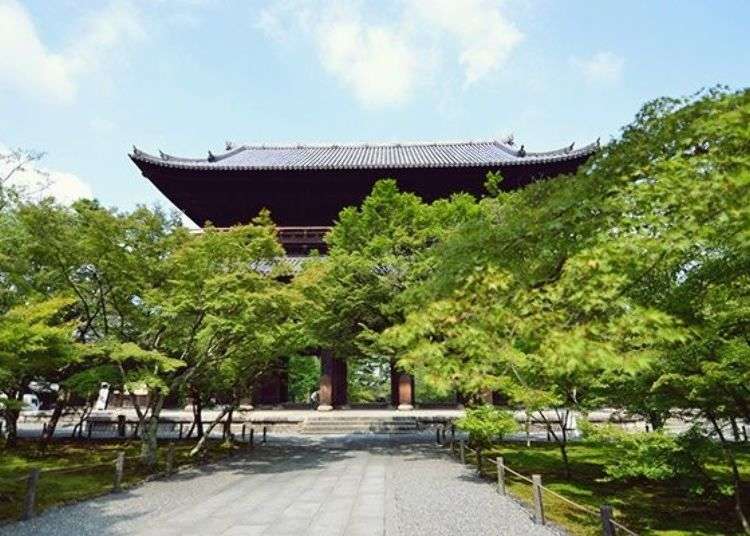
Kyoto's Nanzenji Temple is extraordinarily beautiful in every season, and it seems a postcard-perfect photo awaits at every turn.
There are many beautiful spots in Nanzenji Temple for snapping photos, such as the Sanmon mentioned in the Kabuki play of the same name, the brick aqueduct, and the garden representing a Zen interpretation of the world. Here we'll take you around the grounds of Kyoto's celebrated temple and share some of the best areas for photos.
Brief history of Nanzenji Temple
Nanzenji Temple, located in Kyoto Rakuto, is the main temple of the Rinzai Sect of Zen. It is proudly one of the most famous temples in Kyoto. It was founded about 710 years ago, in 1291. Built in 1264 as a retirement villa for Emperor Kameyama, when he converted to Zen. It then became a Zen temple and Emperor Kameyama took for himself the title of Great Priest.
![▲ Nakamon [Middle Gate] A sign in bold letters indicating this is the head temple](https://rimage.gnst.jp/livejapan.com/public/article/detail/a/20/00/a2000087/img/en/a2000087_parts_5cf723fc70f59.jpg?20201216090110&q=80)
During the Muromachi Period, its status was raised to Gosanshijo, which means a status higher than that of Gosan.
Gosan, literally “five mountains,” represented the five major Zen temples in Kyoto. Accordingly, the status of Nanzenji Temple was placed above them. The temple has been destroyed by fire three times, the first occurring during the Muromachi Period. The present structure was built during the first part of the Edo Period.
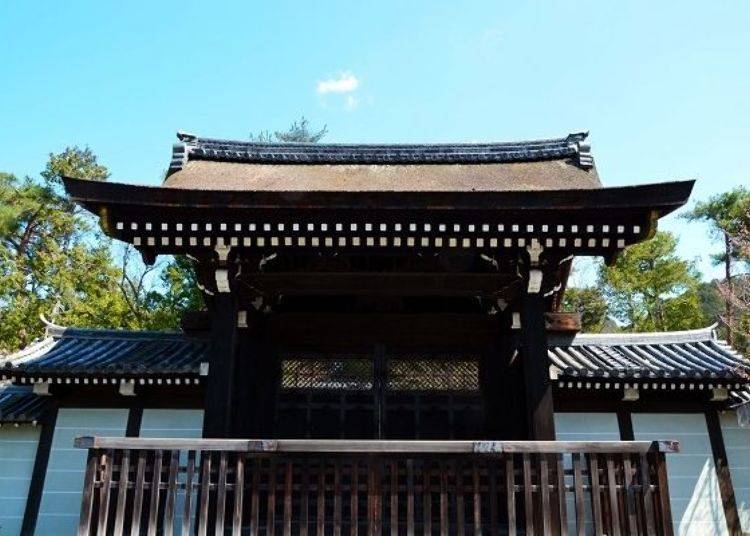
Stroll the grounds of Nanzenji, one of Kyoto's most famous temples
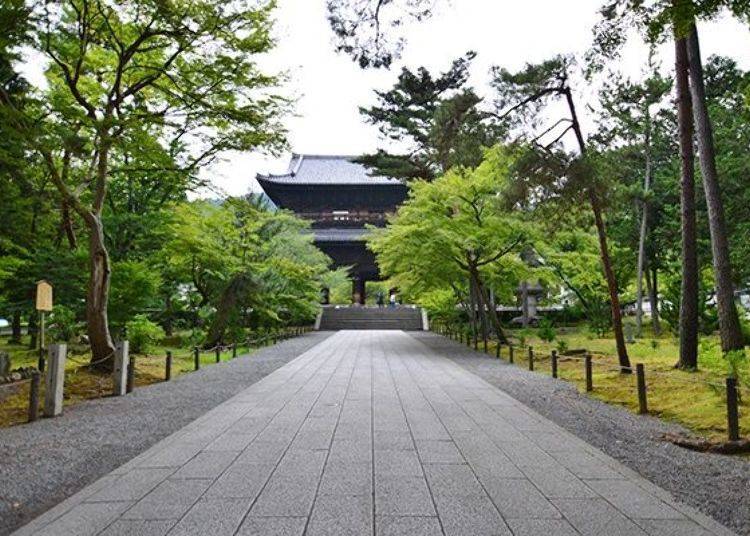
Now let’s take a look inside the temple grounds. After entering through the middle gate, proceed to the left. With the Chokushimon to your back, you will see the Sanmon ahead of you.
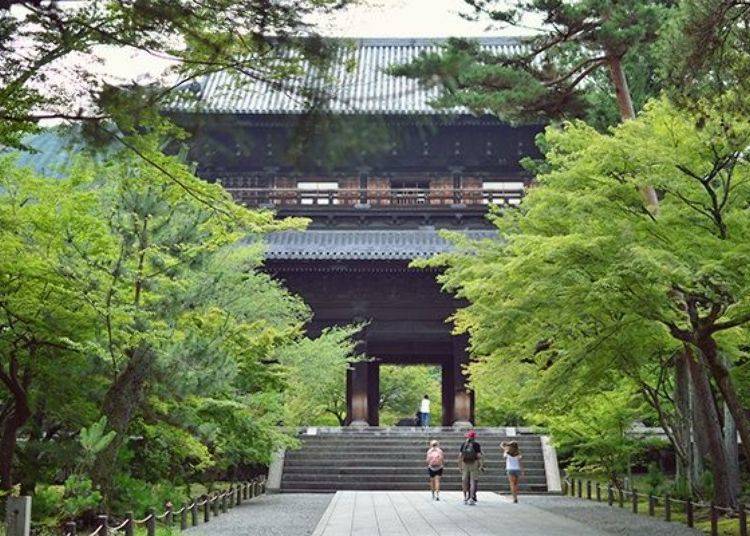
Sample of Nanzenji Temple's Best Photo Spots

This is an excellent place to take a photo at Nanzenji Temple. The Sanmon is also called the Tenkaryumon and is one of Japan's three largest temple gates. It was built and donated in 1628 by Todo Takatora as a memorial to the military commanders and soldiers who fought in the 1615 summer campaign of the siege of Osaka.
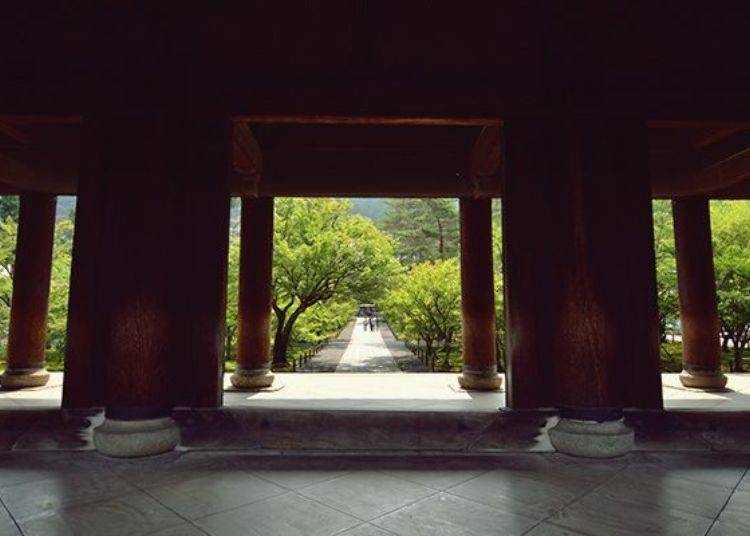
This is the view looking towards the Hatto [sermon hall] through the giant columns of the Sanmon. The beautiful view beyond, framed by the shaded gate, is like a large painting making this an absolute-must photo spot at Nanzenji Temple. The scenery varies from season to season, with cherry blossoms in the spring and autumn leaves radiant in the fall.
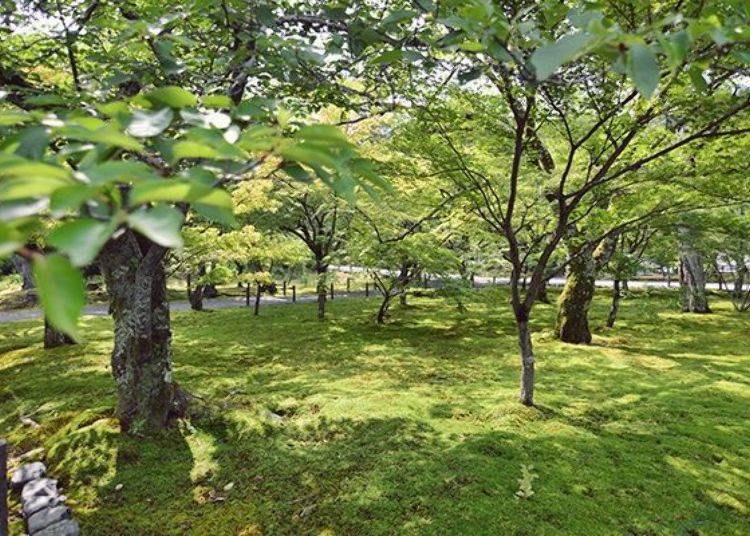
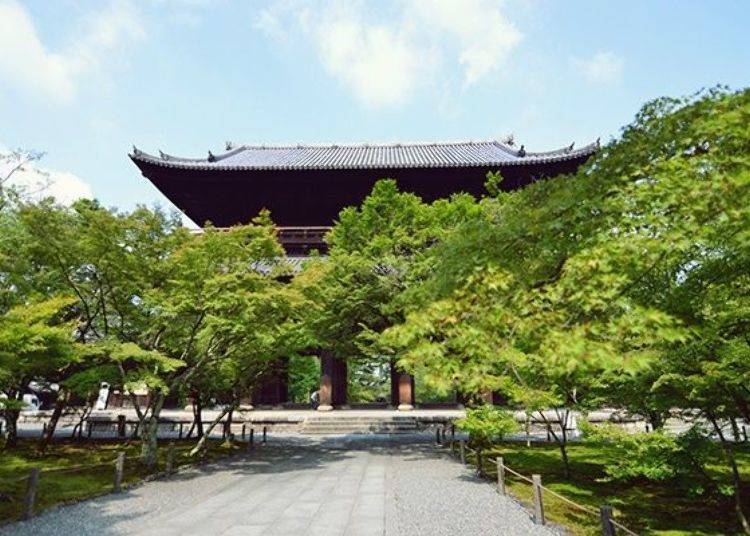
Looking back at Sanmon with Hatto to your back; its stately form rising above the verdant trees. Now let’s go up inside the Sanmon!
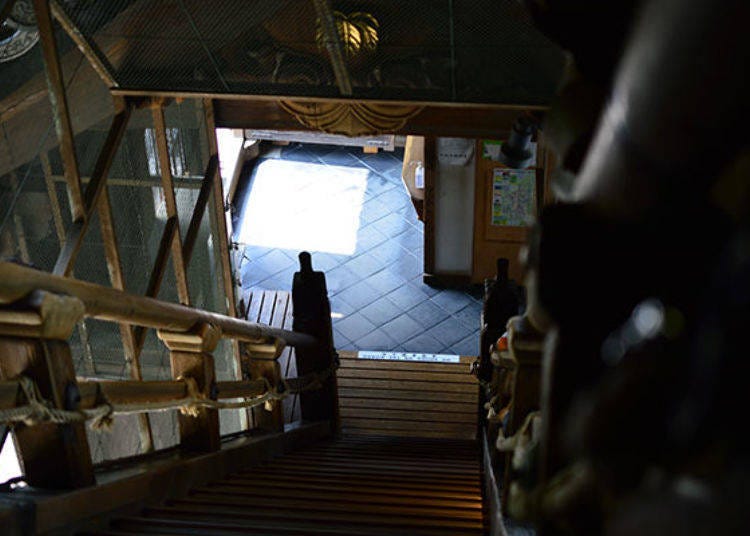
The entrance to the Sanmon is on the Hatto side. You can go up into the gate after paying an admission fee (500 yen for adults, 400 yen for high school students, and 300 yen for elementary and junior high school students) and removing your shoes. Please be careful because the stairs going up are pretty steep.
“It’s the view, the view” - 22 meters high! The view of Kyoto from the massive Sanmon
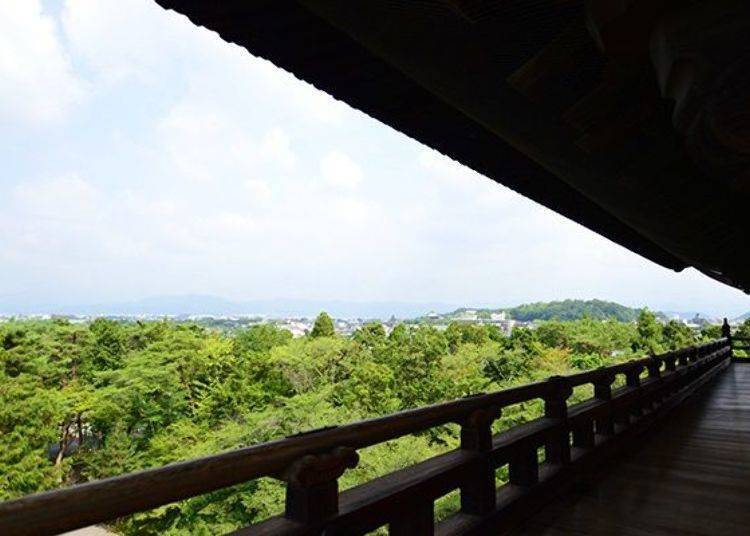
The scene unfolds before your eyes once you reach the top of the steep stairs. There is an exhilarating sense of freedom! The streets of Kyoto lie beyond the trees of the Nanzenji Temple grounds.
In the Kabuki play, Sanmon Gosan no Kiri, Ishikawa Goemon utters the memorable lines, “It’s the view, the view” when looking out at the scenery from the top of the Sanmon. You can take some magnificent photos from the center of the Sanmon as well as from the corners of the balcony, too.
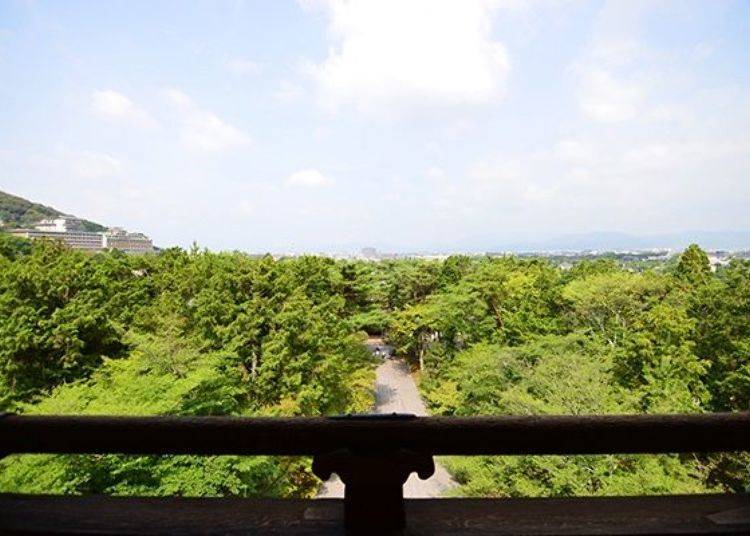
The ceiling, pillars, and beams of the gate tower are painted in scenes of celestial beings and phoenixes in the style of the Kano School, but unfortunately you are not allowed to photograph them. Certainly, though, you will be left with a lasting impression of them.
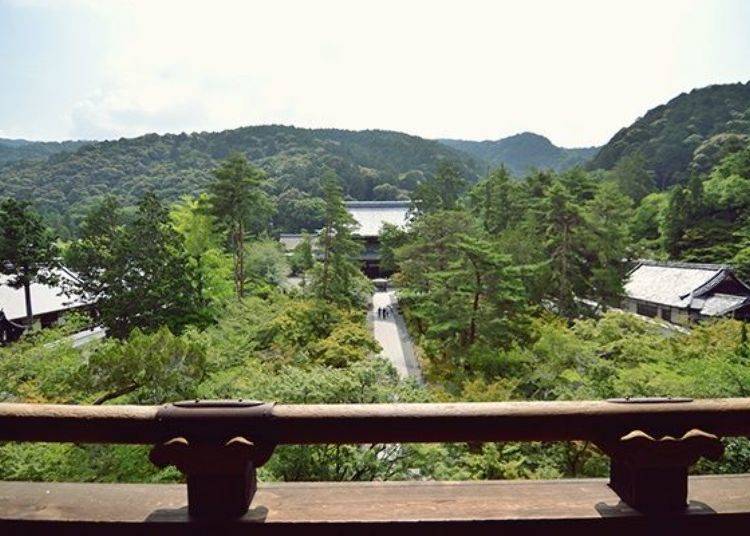
Hatto, Suirokaku Aqueduct, Nanzenin, Hojo Garden...
Still many more photo spots to be introduced!
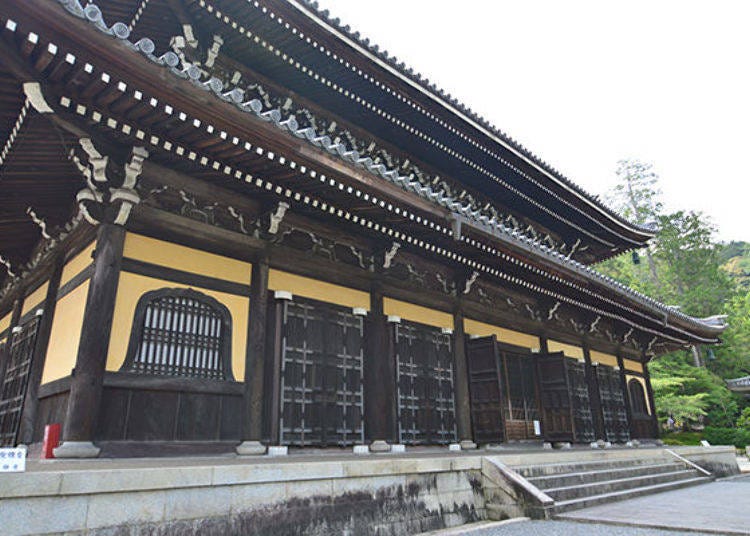
The Hatto is the central structure of the Nanzenji Temple complex and is where formal events and official Buddhist ceremonies are held. The original structure was destroyed by fire, and the current building was rebuilt in 1909.
In Hatto, the three statues of the Gautama Buddha, Manjusri Bodhisattva, and Samantabhadra Bodhisattva are enshrined, and on the ceiling, there is a painting of a dragon by the artist Imao Keinen who was active during the Meiji and Taisho eras.
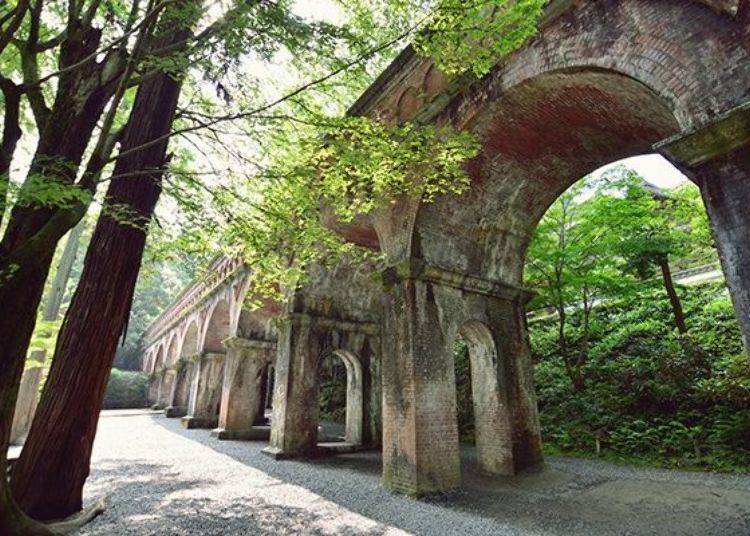
On the south side of Hatto, as you go towards Nanzenin, you will see a brick structure. This is the Suirokaku Aqueduct, a location used in many TV programs and movies. It was constructed in 1890 to bring water from Lake Biwa to Kyoto.

The arched supports produce this view. The old brick construction has a lovely retro feel. This large, Western structure amidst these ancient, famous temples seems incongruous. Still, it is very popular with tourists from overseas and young people who find it an exciting spot for taking pictures.
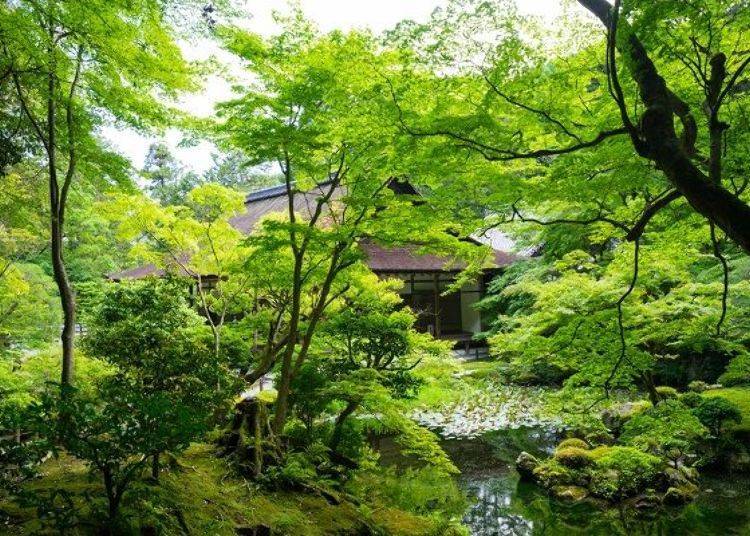
Turning away from the Suirokaku Aqueduct and going up the stairs, you will come to the Nanzenin, which is famous for its garden that features a path around a pond. This is where the palace that was donated by Emperor Kameyama when he became a high priest once stood and is also the place where Nanzenji got its start.
The garden is a vestige from that time and is typical of the ponds with paths around them that were popular at the end of the Kamakura Period; enveloped in lush vegetation, a subtle and profound atmosphere is produced. It is said that High Priest Kameyama created the garden himself, and today is considered one of the three most scenic historical gardens in Kyoto.
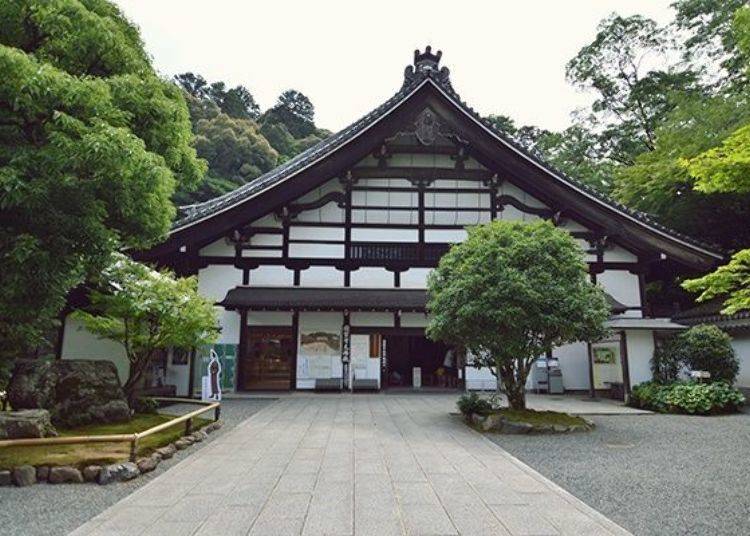
The Hojo Garden, designated a national treasure, is the last place we will introduce.
Hojo is another word meaning "Main Hall of a temple" and corresponds to Kondo and Hondo, which are typically used and have that meaning. The buildings of the Kyoto Imperial Palace were relocated and rebuilt in 1611. After paying an admission fee (500 yen for adults, 400 yen for high school students, and 300 yen for elementary and junior high school students), you can enter after removing your shoes.
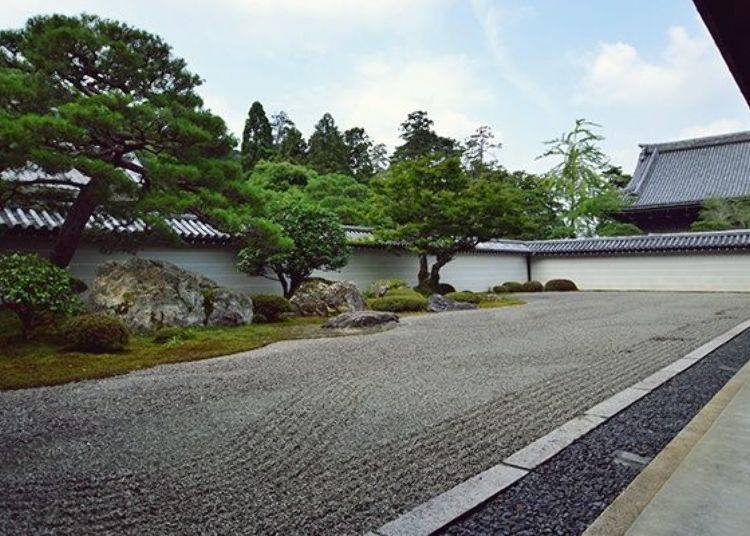
As you walk through the dim corridors, the Hojo Garden, a dry landscape garden typical of the early Edo period, comes into view. It is said to be the work of the gardener Kobori Enshu and is called the Toranoko Watashi no Niwa [Garden of Tiger Cubs Crossing], symbolizing a tiger taking its cubs across a river.

The light-colored gravel represents the river, the large rock the mother tiger, and the smaller rocks the tiger cubs. If you point the camera from the diagonal side of the rock, you will be able to take stunning pictures including a view of Dainichisan in the background.
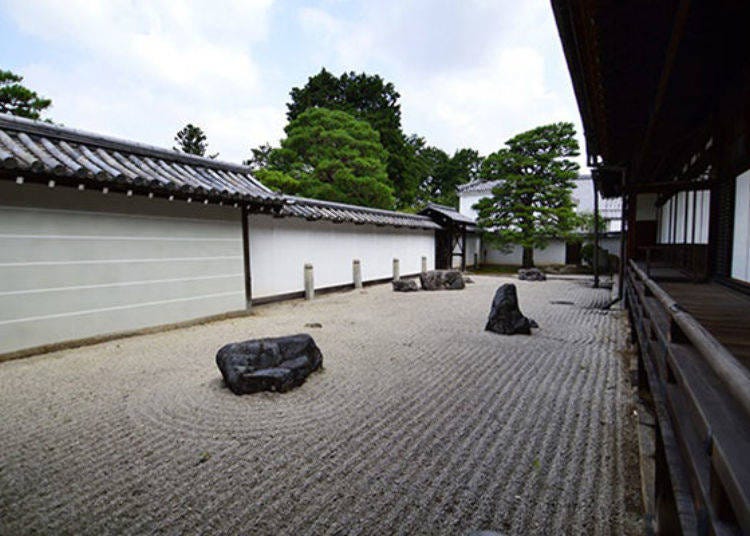
This is the Small Hojo Garden also known as Nyoshintei. The stones in this dry landscape garden are arranged in the shape of the letter kokoro [heart, mind] to convey a sense of calm and enlightenment. Walking around inside the Hojo Gardens, you can view either of the gardens. I felt strangely at peace just looking at the gardens in this Head Temple of Zen.
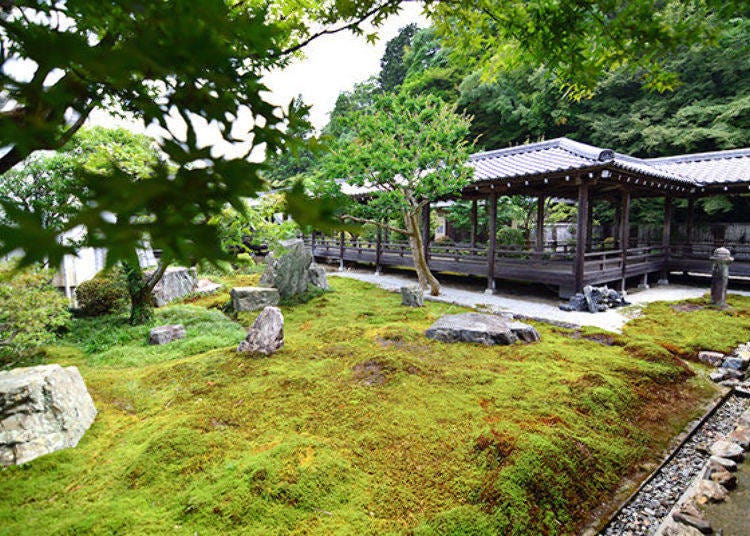
Nanzenji Temple has many photogenic spots such as the dynamic views from the Sanmon, the unusual view through the arches of the old aqueduct, and the peaceful Zen gardens. This is a temple we highly recommend for those wishing to take spectacular photographs.
-

-
Address
Nanzenjifukuchicho, Sakyo-ku, Kyoto-shi, Kyoto, 606-8435
View Map -
Nearest Station
Keage Station (Tozai Line)
10 minutes on foot
- Phone Number 075-771-0365
-
Address
Nanzenjifukuchicho, Sakyo-ku, Kyoto-shi, Kyoto, 606-8435
Text by: Myogaya Nobuhisa
- Area
- Category
*Prices and options mentioned are subject to change.
*Unless stated otherwise, all prices include tax.
Popular Tours & Activitiess
Recommended places for you
-

ISHIDAYA Hanare
Yakiniku
Kobe, Sannomiya, Kitano
-

Kambei Sannomiyahonten
Yakiniku
Kobe, Sannomiya, Kitano
-

Kanzenkoshitsuyakinikutabehodai Gyugyu Paradise Sannomiya
Yakiniku
Kobe, Sannomiya, Kitano
-

Jukuseiniku-to Namamottsuarera Nikubaru Italian Nikutaria Sannomiya
Izakaya
Kobe, Sannomiya, Kitano
-

Abeno Harukas
Landmarks
Shinsekai, Tennouji, Tsuruhashi
-
Goods

Yoshida Gennojo-Roho Kyoto Buddhist Altars
Gift Shops
Nijo Castle, Kyoto Imperial Palace
-

November Events in Kansai: Fun Festivals, Food, and Things to Do in Kyoto & Osaka
-
Ad

Café Bahnhof in Osaka: The home-roasted coffee that captivated G20 leaders!
-

Curious About Sake? I Visited a Sake Brewery in Japan and Here's What I Learned
-

Everything You Need to Know About teamLab Biovortex Kyoto (2025 Insider Guide)
by: Wemmy Chau
-
Ad

Experiencing Manga as Culture, Not Just Reading It: Expo 2025 with Rumiko Takahashi
-

New Way to Reach Koyasan! Ride Nankai's 'GRAN Tenku' for a Heavenly Journey
by: Guest Contributor
Inspiration for Accommodations
-

Spacious Family Hotel in Namba: 20 Comfortable Stays for Family Fun
-

Charming Hotels to Enjoy the Spectacular Views of Arashiyama's Autumn Leaves from Your Room
-

Experience Stunning Views of Osaka Castle from Private Spaces: Top Hotels Near Osaka Castle
-

Recommended by Visitors! Arashiyama's Best-Rated Hotels
-

Family-Friendly Universal Studios Japan Hotel with Excellent Access
-

Enjoy a Comfortable Stay in Osaka! 10 Hotels with Convenient Airport Shuttle Services
-

Top 10 Recommended Hotels Near Namba Station with Great Access
-

Enjoy Night Views from Your Room! Recommended Hotels in Namba Area
-

Michelin Star Restaurants & More: 3 Best Okonomiyaki Shops in Dotonbori Osaka
-

Beyond Stunning! Kyoto’s Most Gorgeous Temples Explored!
by: Steve Csorgo
-

Visiting Nara's Hasedera Temple: This 'Temple of Flowers' Is Home to Stunning Statues!
-

Inside Kyoto's Spectacular Sanjusangen-do Temple with 1,000 Gold Statues
-

Exploring the Timeless Beauty and Spiritual Significance of Nara's Popular Temples
-

3 Best Izakaya In Osaka Where You Can Enjoy Drinks and Local Dishes, Recommended by Locals
- #best gourmet Osaka
- #things to do Osaka
- #what to do in kyoto
- #what to bring to japan
- #best gourmet Kyoto
- #new years in Osaka
- #what to buy in nanba
- #Visiting Osaka
- #onsen tattoo friendly arima
- #daiso
- #Visiting Kyoto
- #best japanese soft drinks
- #japanese fashion culture
- #japanese convenience store snacks
- #japanese nail trends













